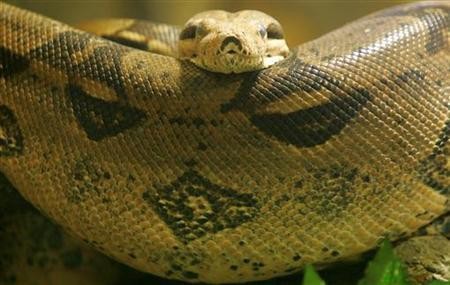
Titanoboa, a nearly 50 feet long gigantic snake that weighed 1,124 kilograms is by far the biggest snake to live on the planet, Earth.
The huge monster, which is 10 times the weight of an average anaconda, lived sixty million years ago in the muddy waters of Colombia. Titanoboa hunted for huge turtles, lungfish and even crocodiles, according to TOI report.
Anacondas that live in swamp bottoms and shallow water can remain underwater for 45 minutes, holding their breath. They can constrict their prey, upto an extent where the prey is unable to breath. Even the prey's blood flow is restricted. But the impact of merciless Titanoboa on its prey can be portrayed as multiple times more than that of a prey trapped under an anaconda.
"It was so outsized that almost certainly it would have spent a large part of its time in water," David Polly, a vertebrate paleontologist at Indiana University, was quoted as saying.
These snakes were good swimmers and were faster on land than on water.
"The climate in the Paleocene when this animal lived was much warmer than it is today. And that would have allowed for bigger reptiles, and indeed not only is there titanoboa, but even in the same site there are crocodiles and turtles that are a lot larger than any living today," Wired.com quoted Polly.
The second largest snake after titanoboa was gigantophis, which was 33 feet long. Gigantophis lived about 40 million years ago in the southern Sahara, now where Egypt and Algeria are situated.
The sudden extinction of titanoboa remains a mystery, but in 2002, the fossil remains of the gigantic snake were uncovered from Cerrejon coal mine, which is one of the world's largest open coal mines, situated in the Rancheria river basin in Colombia, explained Polly.
"And coal is made from the plant remains that essentially fall into the water where they don't decay as rapidly, and they get buried in the sediments that are coming into the water, by way of something like a flood. Over geologic time, these layers turn to different kinds of rock," Polly added.
The fossils have been useful for the paleontologists in discovering many detailed information about the creature and its habitat. The fossil remains were found perished on river bottoms of Colombia, protected from scavengers. Paleontologists uncovered titanoboa fossils in the rocks that were formed from the sediments, particularly clay.
A full model of the monster snake is on display at Smithsonian's National Museum of Natural History.














